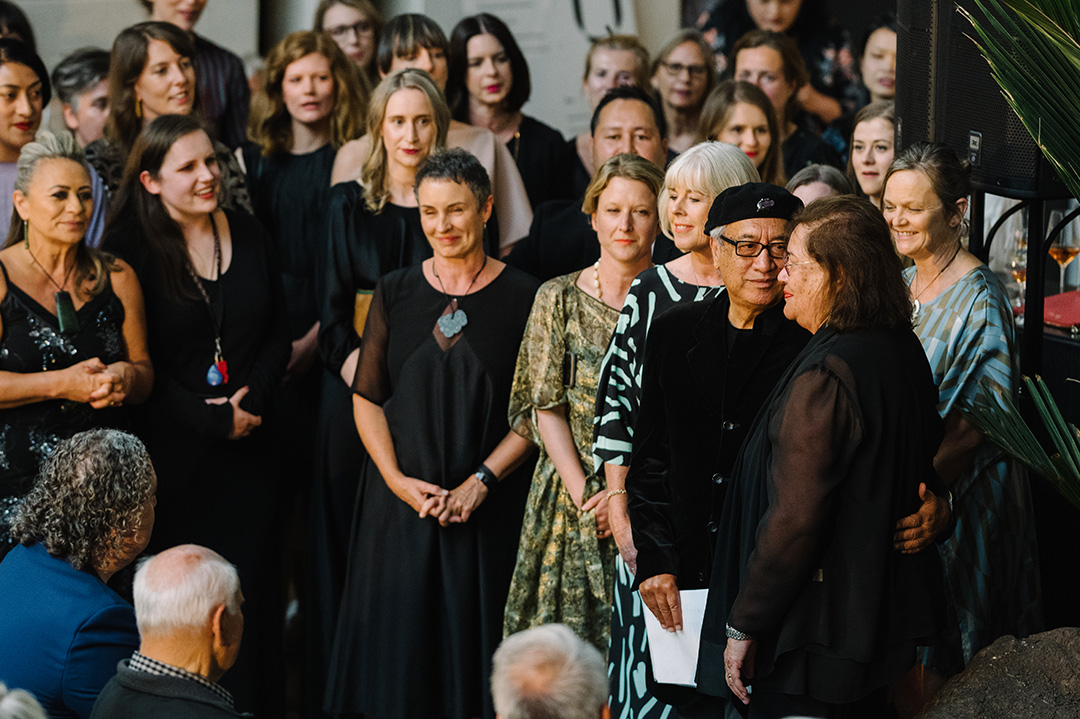This speech was given by celebrated author Witi Ihimaera on 4 December 2020 at the opening event for Toi Tū Toi Ora: Contemporary Māori Art.
In the old days our tupuna would say, ‘Me mātau ki te whetū, i mua i te kōkiri o te haere. Before you set forth on a journey, be sure you know the stars.’
The ancient saying references the times when our ancestors navigated from one constellation to the next across the dark Pacific Ocean until they came to their destination, the zenith or pillar star. The journey of the contemporary Māori artists featured in the sumptuous and extraordinary exhibition Toi Tū, Toi Ora, 1940s to 2020, parallels that odyssey. Some of the artists are here tonight, e hoa mā, we pay tribute to your mana, your ihi, your wehi.
We also pay tribute to your wero, the challenge by which you have demanded the positioning of contemporary Māori art rightfully within the New Zealand conversation.
Here, within New Zealand’s premiere art gallery, Toi o Tāmaki, Nigel Borell and the curatorial team have positioned the kōrero within an overarching mythic whakapapa that takes us back from Te Ao Mārama to Te Pō and to the eternal well of our creative energy, Te Kore. That is where the original umbilical, the pito, emanates from, and I know you will all be moved by the beauty, the epic scope and stature that this genealogy offers to our understanding of the powerful mauri, the stepping stars which have led to here.
They evolved in the 1940s, from such as Arnold Manaaki Wilson and Ralph Hotere mā. A huge reservoir of matauranga Māori was tapped in the 1950s by Buck Nin, Sandy Adsett, Cliff Whiting mā. The energy, the wā, continued to flower in the 1960s: Robyn Kahukiwa, Fred Graham, Para Matchitt mā.
Tenacity was required during the 1970s and 1980s to hold the prow on the stars during the years of the Māori Renaissance by Robert Jahnke, Toi Te Rito Maihi mā. To be frank equity, equality and justice was not easily attained, ask Emare Karaka, eh Emily. But from the 1990s and through the 21st Century our transformational artists - Fiona Pardington, Shane Cotton, Ngaahina Hohaia, Johnson Witehira, Kiri Nathan and Matā Aho Collective mā - have continued to move ngā mahi a ngā tupuna through the many new technologies and digital realms.
‘Me mātau ki te whetū, i mua i te kōkiri o te haere.’
But there have been other stars, other constellations, marking the journey of contemporary Māori art, and those stars offer a different wero, a different challenge. They demand that we position contemporary Māori art not only within the New Zealand conversation but also within the kōrero of international art practice. You need only to look at Arnold Manaaki Wilson’s modernist artwork dating from the postwar 1940s, to know that what I am saying is true.
One of those magnificent constellations was surely the Te Māori exhibition which opened in New York’s Metropolitan Museum of Art in 1984, I took a plane there and was at Chicago, St Louis and Los Angeles. Now pull yourselves along the sky rope with me, to other clusters rising on the night horizon. To Toi Māori Aotearoa taking up the kaupapa of Māori art at, for instance, the British Museum in June 1998; I shared a couple of rooms, meeting house style, with Sandy Adsett and other Te Tairawhiti artists, pork bones and boil ups in a hotel just off Kensington High Street, hard case, things are always darkest before they become totally black.
The sky showers with other starbursts. With travelling to the Venice Biennale where Creative New Zealand sponsored artists Jacqueline Fraser, Peter Robinson, Michael Parekōwhai and Lisa Reihana to the Olympics of the arts in the city of the winged lion. Latterly, I saw another revelatory constellation appear with the Oceania Exhibition at the Royal Academy, London, in 2018 and subsequently in Paris. We must open our eyes. Contemporary Māori artists are already an international phenomenon.
E nga rangatira ma, kui ma, koro ma, on behalf of Haerewa, Elizabeth Ellis and the Māori Advisors charged with coordinating Toi Tū Toi Ora for the Auckland Art Gallery Toi o Tāmaki, nau mai, haeremai, kua tae mai. They invite you with deep love, aroha ki a tatou iwi, to consider with the artists, our relationships with each other. With our country. With this city. With our conflicted past. With the artists themselves individually and collectively. With the potential of rendering internationally our ancient, psychic futures.
Once upon a time the meeting house was our art gallery. Tonight, Auckland Art Gallery has become our wharenui. This is our defining moment, the stars are in transcendent and have guided us home, the pillar star shines above.
But this is not an ending but a beginning. An imaginative child needing to be surprised out of the perilous times we live in – climate change, the pandemic, Black Lives Do Matter, houselessness, the #metoo movement, the rise of terrorism, the international economic recession – is looking for something extraordinary, something breathtaking, something inspirational to keep them on track to a positive future. That child, living in South Auckland or anywhere in this world, seeks the pito, the Māori umbilical, the potential of the Māori Time-space continuum, to reconnect them after Covid and reset the potential of their dreams.
They need only to look to Toi Tū, Toi Ora to find it.
Nā reira, ki nga tupuna rātou o tatou, kua wheturangitia ratou. Nā, ratou, koutou, tatou, tena tatou katoa.

